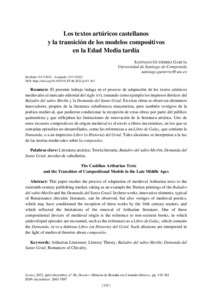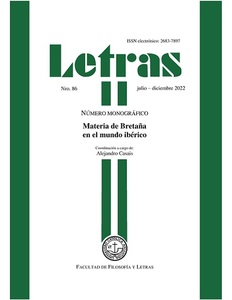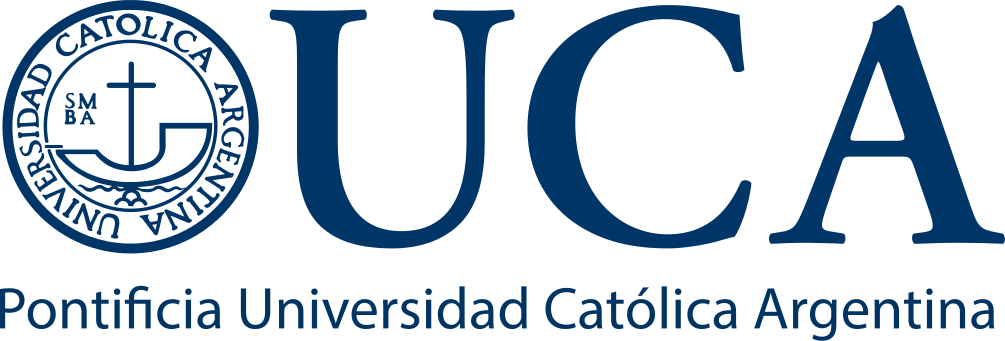Please use this identifier to cite or link to this item:
https://repositorio.uca.edu.ar/handle/123456789/16334| Título: | Los textos artúricos castellanos y la transición de los modelos compositivos en la Edad Media tardía The castilian arthurian texts and the transition of compositional models in the Late Middle Ages |
Autor: | Gutiérrez García, Santiago | Palabras clave: | LITERATURA ARTURICA; TEORIA LITERARIA; Baladro del sabio Merlín; Demanda del Santo Grial; NOVELA DE CABALLERIA; LITERATURA MEDIEVAL | Fecha de publicación: | 2022 | Editorial: | Pontificia Universidad Católica Argentina. Facultad de Filosofía y Letras | Cita: | Gutiérrez García, S. Los textos artúricos castellanos y la transición de los modelos compositivos en la Edad Media tardía [en línea]. Letras. 2022, (86). doi:10.46553/LET.86.2022.p145-161. Disponible en: https://repositorio.uca.edu.ar/handle/123456789/16334 | Resumen: | Resumen: El presente trabajo indaga en el proceso de adaptación de los textos artúricos
medievales al mercado editorial del siglo XVI, tomando como ejemplo los impresos ibéricos del
Baladro del sabio Merlín y la Demanda del Santo Grial. En estas obras se observan elementos
innovadores, propios de la literatura caballeresca renacentista, pero también vestigios de la
poética medieval, que pudieron condicionar la recepción de estas obras por parte del público
quinientista y que reflejaban las limitaciones de renovación de la literatura artúrica. Uno de
estos recursos compositivos de origen medieval es el envío a libros inexistentes, en los que se
contarían episodios no desarrollados, como las referencias a un Libro de Galaz, que contiene la
Demanda, o a un impreciso Libro (o Historia) del Grial. Tales alusiones se interpretan a la luz
de las teorías medievales sobre la compositio. Abstract: This paper studies the process of adaptation of medieval Arthurian texts to the sixteenth-century publishing market, taking as an example the Iberian printings of the Baladro del sabio Merlín and the Demanda del Santo Graal. In these works, innovative elements, typical of Renaissance chivalric literature, can be observed, but also vestiges of medieval poetics, which may have conditioned the reception of these works by the 16th century readers, and which reflected the limitations of the renewal of Arthurian literature. One of these compositional devices of medieval origin is the reference to non-existent books, in which undeveloped episodes are recounted, such as the references to a Libro de Galaz, which contains the Demanda, or to a dubious Libro (or Historia) del Grial. Such allusions are interpreted in the light of medieval theories about compositio. |
URI: | https://repositorio.uca.edu.ar/handle/123456789/16334 | ISSN: | 0326-3363 (impreso) 2683-7897 (online) |
Disciplina: | LITERATURA | DOI: | 10.46553/LET.86.2022.p145-161 | Derechos: | Acceso abierto | Fuente: | Letras No.86, Materia de Bretaña en el mundo ibérico, 2022 |
| Appears in Collections: | LETRAS - 2022 nro. 86 - Materia de Bretaña en el mundo ibérico |
Files in This Item:
| File | Description | Size | Format | |
|---|---|---|---|---|
| textos-artúricos-castellanos.pdf | 260,62 kB | Adobe PDF |  View/Open | |
| cover_issue_471_es_AR.jpg | 39,23 kB | JPEG |  View/Open |
Page view(s)
42
checked on Apr 27, 2024
Download(s)
48
checked on Apr 27, 2024
Google ScholarTM
Check
Altmetric
Altmetric
This item is licensed under a Creative Commons License

